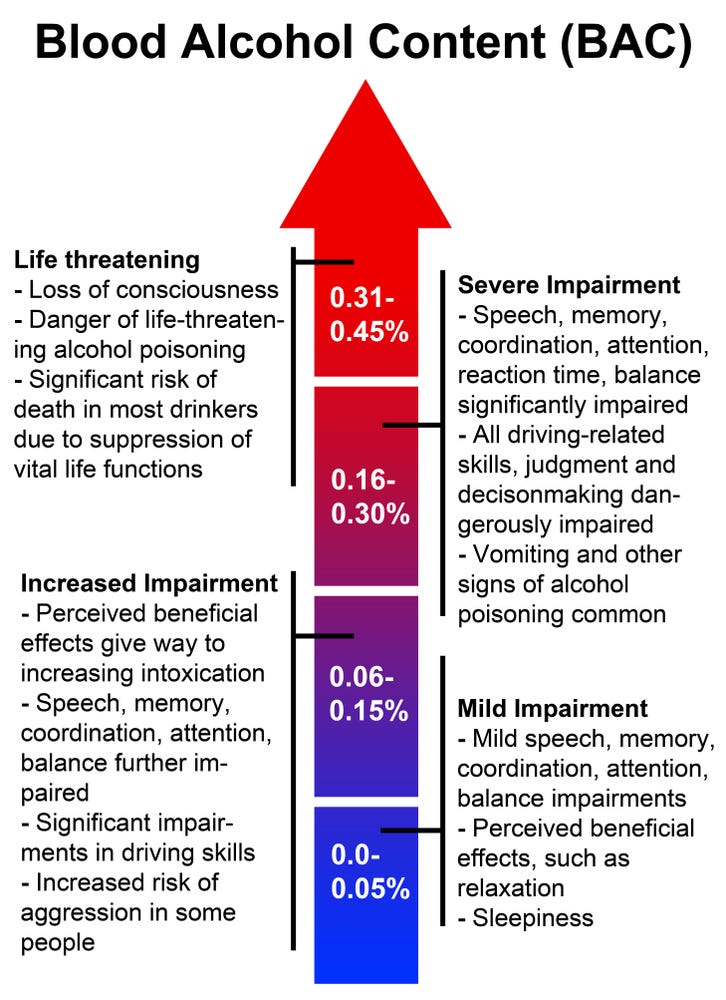Understanding Blood Alcohol Concentration (BAC) in Canada: A Comprehensive Guide
Understanding Blood Alcohol Concentration (BAC) in Canada: A Comprehensive Guide
In the realm of road safety, few factors are as critical as understanding Blood Alcohol Concentration (BAC) levels. This metric not only correlates with impairment but also forms the basis for legal limits regarding driving under the influence (DUI). Drive Aware Foundation is dedicated to the cause of advocating against drunk driving in Canada, it's imperative to illuminate the intricacies of BAC, its effects on cognitive and motor functions, provide practical guidance for individuals, and shed light on the associated penalties.
BAC Levels and Impairment:
In Canada, BAC refers to the concentration of alcohol in an individual's bloodstream, measured in milligrams of alcohol per 100 milliliters of blood (mg/100mL). The effects of alcohol on the body are well-documented, with impairment increasing as BAC levels rise. Understanding the correlation between BAC levels and impairment is crucial, especially concerning safe driving practices.
In Canada, you can face charges if your blood alcohol concentration is in the ‘warn range’ (blood alcohol concentration between 0.05 and 0.079) or more serious penalties if your blood alcohol concentration is 0.08 or more.. Impairment can begin at any level, affecting judgment, reaction time, coordination, and perception of risks, even before reaching the legal limit.
Visual Aids:
Visual aids play a crucial role in illustrating the effects of different BAC levels on cognitive and motor functions. Charts or diagrams can effectively convey this information, making it more accessible to a wider audience.
Consider a chart depicting BAC levels ranging from 0.00% to 0.20% and the corresponding impairments. At 0.05%, there's a noticeable decline in coordination and ability to track moving objects. By 0.10%, significant impairment in reaction time and control is evident, akin to being legally intoxicated for driving purposes. At 0.15%, profound impairment in balance and muscle control is observed, greatly increasing the risk of accidents.
Guidance for Estimating BAC:
The most accurate measure of Blood Alcohol Concentration (BAC) is through the use of breathalyzers. Devices like single-use disposable breathalyzers, such as those offered by Drive Aware Foundation, provide a quick and reliable way to assess BAC levels.
However, if you don't have access to such resources, there are alternative methods to estimate BAC. Factors like body weight, gender, the duration and rate of alcohol consumption, and food intake can provide rough approximations. Various online calculators and smartphone applications are available to help gauge BAC based on these factors. It's important to note that while these methods can provide a general idea of BAC levels, they may not be as precise as breathalyzer tests. Therefore, when in doubt, it's always safer to err on the side of caution and refrain from driving if there's any uncertainty about impairment.
Penalties for Impaired Driving:
Police in Canada have an array of tools and tests to detect impaired drivers, including roadside drug screening equipment and sobriety tests. If the police determine that you are driving while impaired, you can face severe penalties, which can vary depending on factors such as age, license type, the amount of alcohol or drugs in your system, and your history of convictions or license suspensions.
For drivers with a Blood Alcohol Concentration (BAC) between 0.05-0.079 who fail the Standard Field Sobriety Test:
First-time offenders face a 3-day immediate license suspension, a $250 penalty.
Second-time offenders face a 7-day immediate license suspension, enrollment into an education or treatment program, and a $350 penalty.
Third-time offenders face a 30-day immediate license suspension, enrollment into an education or treatment program, an Ignition Interlock condition for six months, and a $450 penalty.
For drivers with a BAC of 0.08 or more who fail or refuse to comply with testing:
First-time offenders face an immediate 90-day roadside suspension, a 7-day vehicle impoundment, and a $550 penalty.
Second-time offenders face the same penalties as first-time offenders, plus enrollment into an education and treatment program.
Third-time offenders face the same penalties as second-time offenders, plus an Ignition Interlock condition for six months.
Additionally, individuals must pay a license reinstatement fee every time their license is suspended.
In conclusion, understanding BAC levels, their implications, and the associated penalties for impaired driving is paramount for promoting road safety in Canada. Through education, enforcement, and advocacy, we can work towards a future with fewer accidents and tragedies caused by impaired driving. As journalists, it's our responsibility to disseminate this knowledge widely and advocate for policies that prioritize public safety on Canadian roads.




